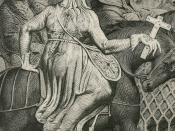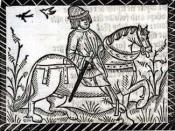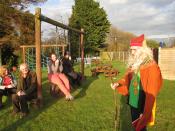Middle English Popular Literature
Write a critical analysis of the passage you choose for discussion, giving due regard to what is going on in the passage, but paying particular attention to the means by which the poet makes his point. Please focus on the passage, but you may need to relate it to the rest of the text or to like texts. You should extend your analysis to considerations of the text's place and work - circulation, function, audience, etc. That is to say, try to present not just a critical but a rhetorical reading of the text you choose to discuss.
Chaucer, The Canterbury Tales,
'The Pardoner's Tale' II. 463-572
In this passage Chaucer sets up a contrast between the Pardoner and the sins he supposedly offers repentance for, to show the Pardoner is more sinned than sinners. He does so through a group of young companions who undertake activities of vice in each others company.
They gamble, solicit prostitutes and frequent taverns together, "Of yonge folk that haunteden foyle/ As riot, hasard, stywes, and taverns" (II. 463-464). Gluttony, lechery and drunkeness are repeated throughout the passage. They are compared to the Devil and devilish activities, "And eten also and drynken over hir myght/ Thurgh which they doon the devel sacrifise/ Withinne that develes temple, in cursed wise" (II. 468-470). Chaucer then uses a biblical analogy to display the significance of the sins. He compares it to the fall of Adam and Eve from the garden of paradise, "adam our fader, and his wyf also/ Fro paradys to labour and to wo/ Were dryven for that vice, it is no drede/ For whil that adam fasted , as I rede/ He was in paradys; and whan that he/ Eet of the fruyt deffended on the tree/...



Pardoner's Tale
Thank you for a very good essay analyzing an interesting passage from Chaucer's Canterbury Tales. You've succeeded in showing in your well researched paper why Chaucer's satire of the Pardoner was so powerful. I appreciate your inclusion of a bibliography so that others may follow up on your research. Great job!
6 out of 7 people found this comment useful.